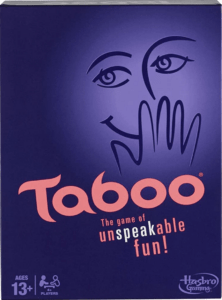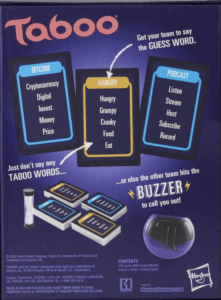My team and I are working on a drinking guessing game called “Bottom’s Up”. This game has 2 teams – one team makes a “mystery drink” with 4 ingredients and the other team has to guess the ingredients after tasting the drink. Both of these tasks need to be done in 3 mins each.
The game I chose for my critical play is Taboo. This was created by Brian Hersch and is usually played offline (although there is an online option as well).

Taboo is a card guessing game that is played in teams. The game is officially supposed to be for 4 or more players, but I think the fun tends to dwindle down as you have more than 8-10 people and this is very similar for our game.
The core elements of the game are – the cards, a timer, players as well as a way to keep score. Some other elements are – categories of cards (color coding) and a buzzer
The mechanics of the game are that each team has an even number of players and each team takes turns “guessing”. This means that 1 player from each team has to make the rest of their team guess as many cards as possible until the timer (1 minute) runs out by verbally guiding them to the correct answer. Each card has “taboo” words which cannot be spoken during the guessing phase.
The dynamics that this creates are that teams want to work together to be able to guess as many words, this leads to “fellowship” kind of fun. If players are competitive, the game can also get intense (in a good way) as everyone wants to win and this leads to the “challenge” kind of fun because you want to challenge yourself to guess more words than the other team. We as humans tend to want to win games we play (even if they are for fun) and that allows for creation of the 2 kinds of fun that I talk about above. It is also human nature to feel a sense of “belonging” with the team you are playing with and that further allows for the fellowship fun to be created.

The cards also have “themes” that are color-coded : blue for tech stuff etc. and the design decision of using colors really helps the players differentiate between the kinds of words the game has — this gets more enforced as you become more familiar with the game. I also really like the decision of highlighting the word to be guessed and having that at the very top (as that is the most important thing for the player). The taboo words are printed below that (in a font that is not much smaller) and I think that is great because being aware of these words is also very important to ensure that you do not make a mistake (but not as important as the word to be guessed). These design decisions ensure that play is smooth and mistakes are avoided.
This game is different from other games in its genre because guessing games usually have you guess one thing per turn (sometimes with a timer). But taboo allows you to guess as many as you can in a minute and that makes it fast paced and very engaging for players — thereby making it more “fun”.
In terms of abuse, the game is usually played with people you know to a certain extent (or with friends of friends), so the chances of abuse are very minimal. There are however, no taboo words that take care of abuse and I would assume if someone has bad intentions, they could try describing the word to be guessed in a very offensive manner and that could be considered abuse.
I would make this game better by adding to the rules that there is a 0 tolerance for abuse and that the rest of the players can choose to remove a player from the game if they think they are violating that (to ensure there is something formally in place to avoid abuse). I would probably also add an interesting dimension wherein if a team guesses more than 8 cards in a minute, they get an extra 15 seconds in their next turn. I think this would incentivise teams to strategise and try to guess more words and that would increase the fellowship and challenge kind of fun.


